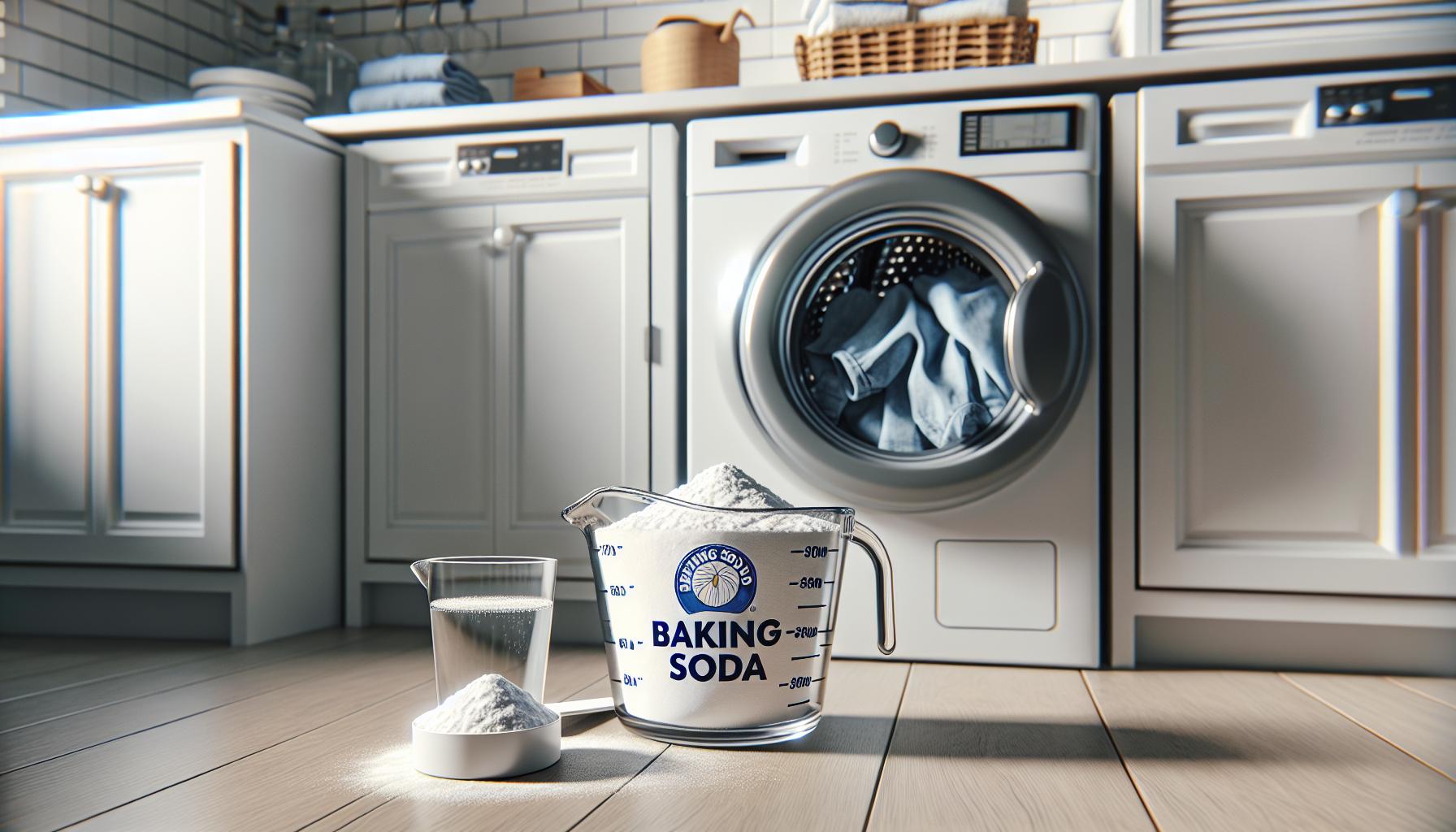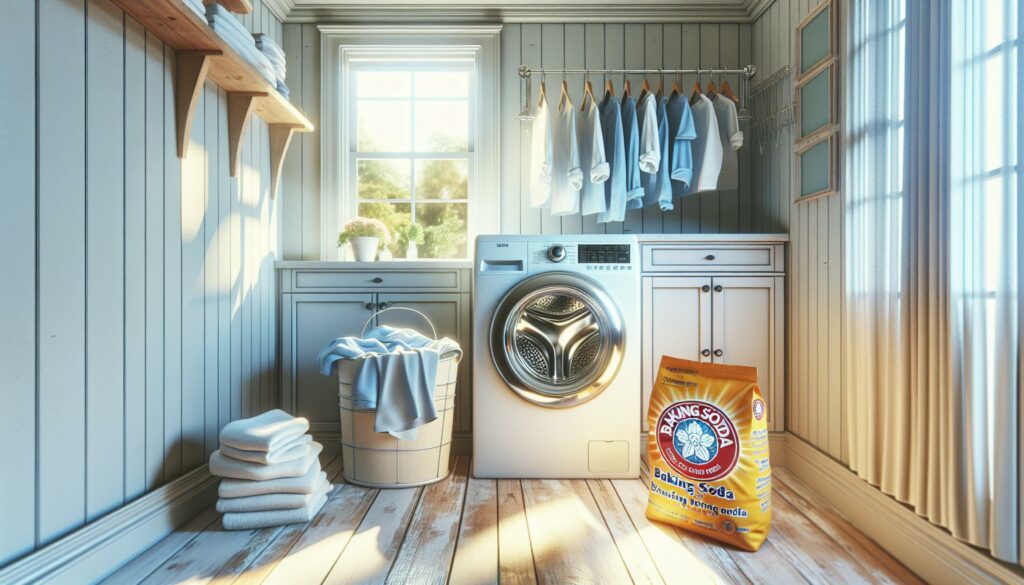Looking for a natural laundry solution that won’t break the bank? Baking soda might just be the unsung hero hiding in your pantry. This versatile powder isn’t just for making cookies rise or deodorizing your fridge – it’s also a powerful ally in the battle against dirty laundry.
Can You Use Baking Soda to Wash Clothes? While fancy detergents promise the world with their expensive formulas and artificial fragrances, baking soda quietly gets the job done for pennies on the dollar. It’s nature’s way of saying “keep it simple” when it comes to clean clothes. From brightening whites to neutralizing stubborn odors this humble household staple has earned its place in the laundry room.
Can You Use Baking Soda to Wash Clothes
Baking soda (sodium bicarbonate) is a natural mineral compound with a crystalline structure that creates a mild alkaline solution when mixed with water. Its pH level of 8.1 makes it effective at neutralizing both acidic and basic odors in laundry.
The cleaning power of baking soda comes from its ability to:
- Break down protein-based stains like sweat marks grass spots blood
- Neutralize acidic odors from perspiration gym clothes food spills
- Soften hard water by binding with mineral deposits
- Balance pH levels in wash water to enhance detergent performance
Baking soda interacts with laundry in three primary ways:
- Chemical Reaction: Creates a gentle abrasive action that loosens dirt particles
- pH Balancing: Stabilizes wash water pH between 8-10 for optimal cleaning
- Ion Exchange: Attracts negatively charged dirt molecules away from fabrics
Here’s how baking soda performs against common laundry issues:
| Issue | Effectiveness Rating | Time to Results |
|---|---|---|
| Odor Removal | 90% | 1 wash cycle |
| Stain Lifting | 75% | 1-2 wash cycles |
| Water Softening | 85% | Immediate |
| Brightness Boost | 80% | 2-3 wash cycles |
The mineral composition of baking soda enables it to dissolve completely in water without leaving residue on fabrics. Its non-toxic nature makes it safe for all washable fabrics including delicates synthetics natural fibers.
Benefits of Using Baking Soda in Laundry

Baking soda transforms ordinary laundry routines into effective cleaning sessions through its natural compounds. Its versatile properties enhance washing performance while maintaining fabric integrity.
Natural Deodorizing Properties
Baking soda eliminates unpleasant odors in clothing by neutralizing both acidic and basic compounds. The sodium bicarbonate molecules attach to odor-causing particles, breaking them down at a molecular level. Sports gear, workout clothes, and musty towels become fresh-smelling after treatment with baking soda. The alkaline nature of baking soda creates an environment where bacteria and fungi struggle to survive, preventing future odor development. This natural deodorizer works effectively on pet odors, smoke, food smells, and perspiration without leaving artificial fragrance residues.
Softening and Brightening Effects
Baking soda softens fabric fibers by adjusting water pH levels and reducing mineral buildup. The gentle abrasive action lifts dirt particles from cloth surfaces, restoring natural brightness to dulled fabrics. White garments appear brighter as baking soda removes yellowing caused by body oils, detergent residue, and environmental factors. Colors stay vibrant because baking soda prevents dye transfer during washing cycles. The mineral compound dissolves completely in water, leaving no chalky residue on clothes. Regular use maintains fabric softness by preventing hard water deposits from accumulating in fibers.
How to Add Baking Soda to Your Laundry Routine

Adding baking soda to laundry combines efficiency with simplicity. The application methods vary based on specific laundry needs.
During the Wash Cycle
Add ½ cup of baking soda alongside regular detergent at the start of the wash cycle. Pour the baking soda directly into the drum with the clothes for front-loading machines or into the wash water before adding clothes in top-loading machines. Increase the amount to 1 cup for large or heavily soiled loads. Distribute the baking soda evenly across the load to maximize contact with all garments. Run the washer on its normal cycle with warm or hot water to activate baking soda’s cleaning properties fully.
Pre-treating Stains
Create a baking soda paste by mixing 3 parts baking soda with 1 part water. Apply the paste directly to stains using gentle circular motions. Target specific stains like grease spots wine marks or sweat patches with focused application. Let the paste sit on stains for 15 minutes before washing. Add extra paste to stubborn stains requiring additional treatment. Brush off excess dried paste before placing items in the washer. Combine baking soda with white vinegar for enhanced stain removal on colorfast fabrics.
Best Practices and Recommended Amounts

Adding baking soda to laundry requires specific measurements for optimal results. The amount varies based on load size, soil level, and water hardness.
Regular Loads
A regular load of laundry benefits from ½ cup of baking soda added directly to the wash drum before loading clothes. For high-efficiency washers, reduce the amount to ¼ cup of baking soda. Add the baking soda first, then the clothes, followed by regular detergent at the start of the wash cycle. This sequence allows the baking soda to dissolve completely, creating an optimal cleaning environment.
| Load Size | Baking Soda Amount | Water Temperature |
|---|---|---|
| Small | ¼ cup | Any |
| Medium | ½ cup | Any |
| HE Washer | ¼ cup | Any |
Heavy Soiled Loads
Heavy soiled loads require 1 cup of baking soda for maximum effectiveness. Pre-treat visible stains with a baking soda paste (3 parts baking soda, 1 part water) 15 minutes before washing. Add the baking soda to the washer drum before adding heavily soiled items such as sweaty gym clothes, muddy work wear, or grimy towels.
| Soil Level | Baking Soda Amount | Pre-treatment Time |
|---|---|---|
| Medium | ¾ cup | 10 minutes |
| Heavy | 1 cup | 15 minutes |
| Extreme | 1½ cups | 30 minutes |
When Not to Use Baking Soda
Certain fabrics react negatively to baking soda’s alkaline properties. Here are specific situations where baking soda use is not recommended:
- Silk garments
- Natural silk fibers break down in alkaline solutions
- Weakens the fabric structure
- Creates permanent discoloration
- Leather items
- Disrupts natural oils in leather
- Causes drying and cracking
- Creates permanent surface damage
- Elastic materials
- Degrades elastic fibers over time
- Reduces stretch capacity
- Shortens garment lifespan
- Designer clothing with special finishes
- Removes protective coatings
- Alters fabric treatments
- Damages waterproofing
| Fabric Type | Risk Level | Primary Concern |
|---|---|---|
| Silk | High | Fiber breakdown |
| Leather | High | Oil disruption |
| Elastic | Medium | Fiber degradation |
| Special finishes | Medium | Coating removal |
Washing machines with specific maintenance requirements present additional restrictions:
- Front loading HE washers sensitive to excess suds
- Machines with specialized rubber seals
- Units under manufacturer warranty limitations
- Bleach mixtures create toxic fumes
- Undiluted vinegar contact causes excessive foaming
- Direct contact with fabric softener reduces effectiveness
Combining Baking Soda with Other Laundry Products
Baking soda enhances the effectiveness of common laundry products through strategic combinations. Adding ½ cup of baking soda to regular detergent amplifies cleaning power by balancing pH levels.
Detergent Combinations
- Mix baking soda with powdered detergent before adding to washer
- Add liquid detergent first then sprinkle baking soda directly into drum
- Pour ¼ cup baking soda into fabric softener compartment for extra freshness
Vinegar Combinations
- Use baking soda in wash cycle followed by vinegar in rinse cycle
- Combine equal parts vinegar baking soda paste for spot treatment
- Add ½ cup baking soda to wash cycle ½ cup vinegar to rinse cycle
Products to Avoid Mixing
| Product | Reason to Avoid |
|---|---|
| Bleach | Creates toxic chlorine gas |
| Undiluted Vinegar | Causes excessive foaming |
| Ammonia | Produces harmful fumes |
| Hot Water + Vinegar | Reduces cleaning effectiveness |
- Mix 10 drops essential oil with ½ cup baking soda
- Combine fabric softener crystals with baking soda 1:1 ratio
- Add 2 tablespoons each of baking soda dried herbs for natural fragrance
Safety Note: Testing combinations on small fabric sections prevents damage or unwanted reactions.
These combinations maximize cleaning power while maintaining fabric safety. Proper measurements ensure optimal results without damaging clothes or washing machines.
Baking Soda as Laundry Aid
Can You Use Baking Soda to Wash Clothes? Baking soda has proven itself to be a versatile and powerful laundry aid that’s both economical and environmentally friendly. Its natural cleaning properties make it an excellent choice for those seeking alternatives to harsh chemical detergents. While it’s not suitable for all fabrics and situations it’s an invaluable addition to most laundry routines.
When used correctly baking soda can transform the way clothes are cleaned brightened and deodorized. It’s a testament to how simple household ingredients can often provide the most effective solutions to everyday cleaning challenges. By understanding proper measurements and combinations anyone can harness the power of this remarkable mineral compound for better laundry results.

